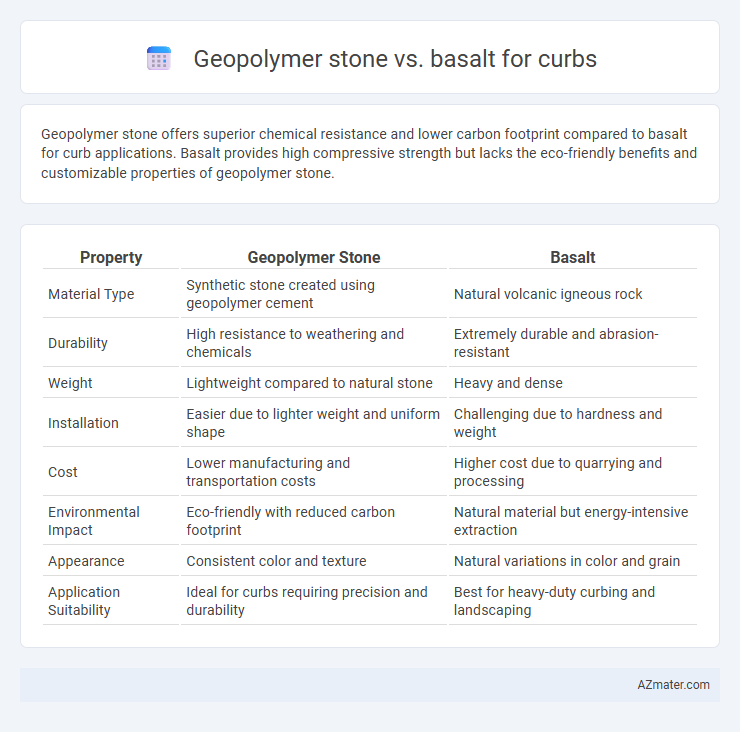Geopolymer stone offers superior chemical resistance and lower carbon footprint compared to basalt for curb applications. Basalt provides high compressive strength but lacks the eco-friendly benefits and customizable properties of geopolymer stone.
Table of Comparison
| Property | Geopolymer Stone | Basalt |
|---|---|---|
| Material Type | Synthetic stone created using geopolymer cement | Natural volcanic igneous rock |
| Durability | High resistance to weathering and chemicals | Extremely durable and abrasion-resistant |
| Weight | Lightweight compared to natural stone | Heavy and dense |
| Installation | Easier due to lighter weight and uniform shape | Challenging due to hardness and weight |
| Cost | Lower manufacturing and transportation costs | Higher cost due to quarrying and processing |
| Environmental Impact | Eco-friendly with reduced carbon footprint | Natural material but energy-intensive extraction |
| Appearance | Consistent color and texture | Natural variations in color and grain |
| Application Suitability | Ideal for curbs requiring precision and durability | Best for heavy-duty curbing and landscaping |
Introduction: Geopolymer Stone vs Basalt for Curbs
Geopolymer stone offers enhanced durability and environmental sustainability compared to traditional basalt for curbs, utilizing industrial byproducts to reduce carbon footprint. Basalt, a natural volcanic rock, is prized for its hardness and weather resistance but involves energy-intensive quarrying. Choosing geopolymer stone for curbs supports eco-friendly urban infrastructure without compromising on strength and longevity.
Material Composition and Origin
Geopolymer stone is an engineered material composed of industrial byproducts like fly ash or slag combined with alkaline activators, originating from innovative recycling processes, while basalt is a natural volcanic igneous rock formed from rapidly cooled lava flows. Geopolymer stone's composition allows for customizable properties including enhanced chemical resistance and reduced carbon footprint, contrasting with basalt's dense, naturally weather-resistant mineral matrix primarily made of plagioclase and pyroxene. The synthetic origin of geopolymer stone offers sustainability advantages and consistent performance, whereas basalt's geological origin provides inherent durability and high compressive strength suited for curb applications.
Strength and Durability Comparison
Geopolymer stone exhibits high compressive strength often surpassing 70 MPa, providing exceptional durability against weathering and chemical exposure, making it ideal for curbs in urban environments. Basalt, a natural volcanic rock, typically offers compressive strength around 100-300 MPa and excellent abrasion resistance, contributing to long-lasting curb performance under heavy traffic load. While basalt's natural properties ensure robust durability, geopolymer stone's engineered composition allows tailored strength and enhanced resistance to freeze-thaw cycles, presenting a competitive alternative for sustainable infrastructure.
Environmental Impact and Sustainability
Geopolymer stone exhibits a significantly lower carbon footprint compared to basalt due to its use of industrial byproducts like fly ash and slag, reducing reliance on virgin materials and minimizing landfill waste. The production of geopolymer stone consumes less energy and emits fewer greenhouse gases than basalt quarrying and processing, enhancing overall environmental sustainability. Additionally, geopolymer stone offers durability and resistance to weathering, contributing to a longer lifespan for curbs and reducing the need for frequent replacements.
Cost Analysis and Economic Impact
Geopolymer stone offers a lower initial cost compared to basalt due to its ability to utilize industrial byproducts, reducing raw material expenses and energy consumption during production. Basalt, while more expensive upfront, provides superior durability and requires less maintenance over time, potentially offsetting initial costs in long-term infrastructure projects. Economic impact analysis reveals that incorporating geopolymer stone can promote sustainable construction practices with reduced carbon footprint, while basalt's high performance supports investment in resilience and longevity of curbs in urban developments.
Installation Process and Requirements
Geopolymer stone offers easier installation for curbs due to its lightweight nature and moldability, requiring less heavy equipment and shorter curing times compared to basalt, which is denser and demands specialized cutting tools and longer setting periods. Basalt curbs often need excavation with precision drilling and heavy machinery to handle their higher weight and hardness, increasing labor and equipment costs. The installation of geopolymer stone benefits from its chemical composition allowing for onsite molding and faster setting, reducing overall project timelines.
Weather and Chemical Resistance
Geopolymer stone exhibits superior chemical resistance compared to basalt, effectively withstanding acidic rain and de-icing salts commonly found in road environments. Basalt, while naturally durable, is more susceptible to weathering and chemical erosion over time, leading to surface degradation and structural weakening. The enhanced resistance of geopolymer stone to both weather fluctuations and chemical exposure makes it a preferred material for long-lasting and low-maintenance curbs.
Aesthetic Appeal and Customization Options
Geopolymer stone offers a versatile aesthetic appeal with its ability to mimic natural stone textures and colors, providing a broad range of customization options for curbs, including tailored shapes and finishes. Basalt, known for its dense, fine-grained structure, presents a sleek, natural dark hue that adds a modern and durable look but offers limited customization beyond its inherent form. Choosing between geopolymer stone and basalt depends on the desired visual impact and flexibility in design, with geopolymer stone leading in customizable appearance and basalt excelling in natural, uniform aesthetics.
Maintenance and Longevity
Geopolymer stone offers superior resistance to weathering and chemical corrosion compared to basalt, resulting in lower maintenance requirements over time. Basalt, while naturally durable and strong, may require periodic sealing to prevent surface degradation and prolong lifespan. Overall, geopolymer stone tends to provide enhanced longevity and reduced upkeep costs for curb applications.
Best Applications and Suitability for Curb Projects
Geopolymer stone offers excellent durability and chemical resistance, making it ideal for curb projects in urban environments exposed to de-icing salts and pollution. Basalt provides superior compressive strength and natural aesthetic appeal, suitable for high-traffic curb areas requiring long-term structural integrity. Both materials excel in sustainability, with geopolymer stone using industrial by-products and basalt sourced from natural volcanic rock, aligning with eco-friendly construction goals.

Infographic: Geopolymer stone vs Basalt for Curb
 azmater.com
azmater.com